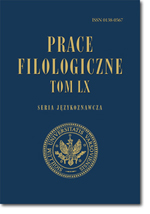Funkcje morfemu {-ną-} w polskich czasownikach
Functions of the morpheme {-ną-} in Polish verbs
Author(s): Henryk WróbelSubject(s): Language and Literature Studies
Published by: Wydział Polonistyki Uniwersytetu Warszawskiego
Keywords: czasownik duratywny; iteratywny; kauzatywny; semelfaktywny; teliczny; morfem; sufiks tematyczny; temat fleksyjny; durative; iterative; casuative; semalfactive; telic verbs; morpheme; thematic suffix; inflectional theme
Summary/Abstract: The functions of the verbal morpheme {-ną-} and its alternants are assigned to them by the relations between the verbs containing this morpheme and other lexemes built on the same root and having cognate meanings. The analysis of the relations shows the following functions in different semantic groups of verbs: a) word-formation semantic functions: a1) in imperfective verbs of process derived from adjectives, eg. {chudnąć ← chudy}; a2) in perfective semelfactive verbs derived from imperfective durative ones, e.g. {kapnąć ← kapać, pisnąć ← piszczeć}; a3) signalling unidirectional movement vs. non-unidirectional movement in several verbs, e.g. {płynąć ← pływać}; a4) changing imperfective aspect into perfective aspect in telic verbs, eg. {sprzątnąć ← sprzątać}; b) inflectional function in all the verbs in question: forming secondary stems on which the verbal forms are built; the absence of the morpheme in the past tense of some verbs depends partly on its function or tradition.
Journal: Prace Filologiczne
- Issue Year: 2011
- Issue No: 60
- Page Range: 331-340
- Page Count: 10
- Language: Polish

